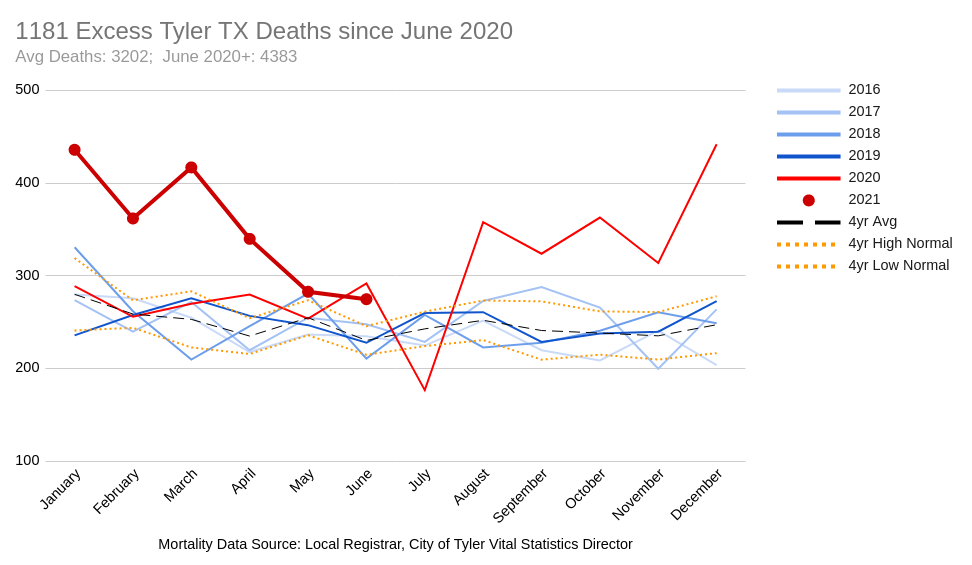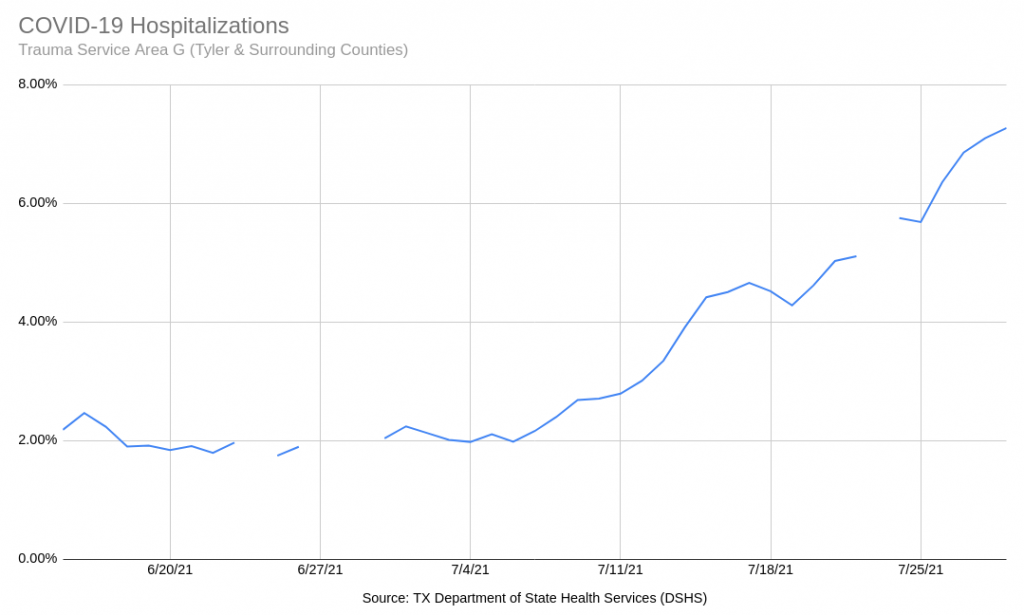COVID-19 is again rearing its head in a national surge. What have been Smith County’s losses so far? And is the worst over?
The data shows the damage to date: 1,181 extra county deaths. Meanwhile, new data shows cause for concern: recent hospitalization increases, low vaccination numbers and testing slowed to a trickle. Here is the summary.
Deaths and discrepancies
It’s been 12 months since Tyler’s death rate began skyrocketing. In the deadliest year ever recorded in Tyler, 1,181 extra people died above the average death rate from the previous four years from June 2020-June 2021.
After topping out at an astonishing 6.94 times the standard deviation in February as the holiday surge victims died, the death rate has been declining for the last several months, proving the vaccines work. Unfortunately, June of 2021 was still 2.88 times the standard deviation.

Forty-four extra people died in Tyler during June 2021. Those numbers are alarming, but appear benign compared to March, when 163 extra people died.
The Northeast Texas Public Health District (NETHealth) maintains that 300 Smith County residents have died of COVID-19. The State of Texas says otherwise. The Department of State Health Services (DSHS) counts 482 deaths of Smith County residents due to COVID-19. The 182 death difference — not included in the 1181 total, above — at first appears to be because NET Health is counting only deaths of county residents which occur physically in Smith County. By contrast, DSHS numbers include deaths of Smith County residents which occur anywhere in the state of Texas. As the Tyler Morning Telegraph illustrates, gravely ill county residents are sometimes sent to places like Plano for specialized care.
George Roberts, CEO of NET Health responded to The Tyler Loop’s query about the difference in deaths reported. “With COVID 19, we saw that there were many East Texas residents hospitalized in Tyler, Texas, hospitals. And due to the seriousness of how COVID 19 impacted individuals, people from all over the East Texas region unfortunately passed away from COVID 19 in the Tyler hospitals,” he said.
Since COVID-19’s onset, NET Health reports 568 people have died of the virus in nearby counties. If 100% of those 568 cases came to Tyler to die, the death rate for Smith County residents would still be nearly twice NET Health’s official rate.
Hospitalizations

On January 10, 2021 one out of every four hospital beds in Trauma Service Area G — Tyler and surrounding counties — were filled by COVID-19 patients. As vaccination rates rose in February, 2021 the COVID-19 bed rate began declining. By the end of March, the number of beds used by COVID-19 patients was hovering near 2%, where it remained until recently.
Then came the Delta variant. In the week of July 7-14, 2021, Trauma Service Area G COVID-19 hospitalizations doubled from 2% to 4%. They are now up over 300% from July 7 and show no sign of declining.
Vaccinations and a years-long lag to reach herd immunity
The existence of the COVID-19 vaccine has not eradicated the presence of the virus. Today three out of 10 elderly in Smith County still are not fully vaccinated. In the general population, only four in 10 are vaccinated. And of course, no elementary school age children are vaccinated. All of these groups are at risk of contracting the virus with no safeguard against severe sickness or fatality.
In March and April, Smith County vaccinated over 1,000 people daily, putting it on track to achieve herd immunity and put COVID-19 behind us by sometime in 2022. Since then, the numbers have stalled. The county now gives only 200-300 shots a day. At this rate, Smith County will not be “done” vaccinating until sometime in the second half of the decade.
Testing
As a way to determine if a specific patient has COVID-19, testing is effective.
Additionally, testing is helpful in determining how widespread COVID-19 is within the community. But almost a year and a half into the pandemic, Smith County appears to have no systematic strategic plan for testing.
Apart from a large surge in testing near the end of December 2020 just before the holidays, Smith County’s testing numbers have remained relatively low. Over the last few months, the county has generally tested fewer than 150 people per 100,000 daily and have sometimes tested fewer than 100 per 100,000.
The Community Spread score relies on testing to count positive cases and should be predictive of hospitalizations a week into the future and of deaths in three or four weeks. By contrast, Tyler’s Community Spread score lagged the most recent hospitalization surge by a week.
Tests in the county are primarily administered if a patient exhibits “classic” COVID-19 symptoms or if they specifically request a test. Testing is rare for asymptomatic people and people with mild symptoms, such as children.
The current rate of testing in Smith County does not appear to be sufficient to support any meaningful conclusions, positive or negative, about COVID-19 in the broader community. In other words, Tyler is fighting the pandemic with little use from one of its cheapest, most useful tools.
As the Delta variant spreads and students return to school next month, the county can likely expect the surge to continue rising.
Stephen Fierbaugh was lead IT Project Manager for a large hospital ship being built in China. Now, he’s looking for new places to serve. Are these statistics helpful? Would you like to see similar information for your city or organization? Stephen has his Masters in Intercultural Studies with a focus on ICT4D (technology) and is PMI certified as a Project Management Professional (PMP). Check out his LinkedIn for more examples of his skills and experience.
Love what you're seeing in our posts? Help power our local, nonprofit journalism platform — from in-depth reads, to freelance training, to COVID Stories videos, to intimate portraits of East Texans through storytelling.
Our readers have told us they want to better understand this place we all call home, from Tyler's north-south divide to our city's changing demographics. What systemic issues need attention? What are are greatest concerns and hopes? What matters most to Tylerites and East Texans?
Help us create more informed, more connected, more engaged Tyler. Help us continue providing no paywall, free access posts. Become a member today. Your $15/month contribution drives our work.







